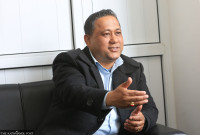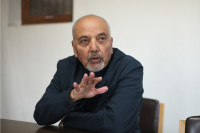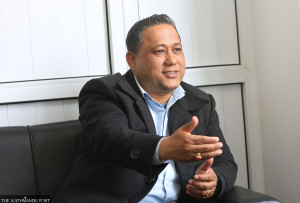Interviews
Rajan Pokhrel: We are 10 years behind in our aviation infrastructure
The chief of Nepal’s Civil Aviation body on how it plans to manage the Kathmandu airport on the eve of Visit Nepal 2020..jpg&w=900&height=601)
Sangam Prasain
Rajan Pokhrel was appointed the Director General of Civil Aviation Authority of Nepal in June. Pokhrel, who has served as chief of the safety department at the authority for a long time, says Nepal’s civil aviation is still at crossroads with several issues that need to be urgently addressed. New airports are being constructed, and there are many unsettled issues regarding new air routes. Visit Nepal 2020 is right around the corner and Nepal’s severely congested sole international airport is almost pathetic. One of the biggest challenges is to remove Nepal from the air safety list of the European Commission. The Post’s Sangam Prasain sat with Pokhrel to discuss the way forward for Nepal’s burgeoning aviation industry.
This interview has been condensed for clarity.
Visit Nepal 2020 is just around the corner and Nepal is expecting a record number of tourists. But Tribhuvan International Airport is already congested and cannot be expanded. How will it deal with the growing traffic?
True, the airport has been facing severe congestion due to ongoing construction airside activities. We started rehabilitating the five-decade-old runway and taxiway of the country’s only international airport targeting Visit Nepal 2020. We are also expanding the parking bays. The runway rehabilitation is already complete while the taxiway rehabilitation will be completed by December. As aircraft are occupying the runway or using it as a taxiway to reach the takeoff point, the time for a plane to takeoff has doubled to 4 minutes. This has resulted in significant flight delays and congested the airport as well. From January 2020, airport congestion will be reduced significantly as it will be able to handle flights 24/7. After the rehabilitation of the taxiway is complete, the airport will be opened for 21 hours.
As delays are basically during the day time—from 2 pm to 6 pm—we are also revising the slot allocation time for both domestic and international airlines for proper traffic management.
What about the second international airport in Bhairahawa? Will it come into operation by the end of March as planned?
The project ran into controversies from the beginning, and there are still many problems. The contractor has not released payments amounting to millions of dollars for many suppliers. We are concerned, but we cannot decide to immediately terminate the contract as it will not benefit us. The Civil Aviation Authority of Nepal has gone beyond its limit to support the contractor so that the airport can be completed on time. We have assured payments for suppliers because we don’t want another setback in the project.
After several deadline extensions, the contractor has been given until March to complete the project. If the runway lightning, air traffic management and navigation system are installed, we can test-run the airport by the first week of June. But it’s a tight schedule.
How do you assess Nepal’s civil aviation safety status? Why aren’t we still out of the European Commission’s air safety list even after six years?
On December 5, 2013, the European Commission put Nepal on the European Union air safety list as it found the country lacking the ability to oversee aviation safety issues. On April 11, the European Commission, the executive branch of the European Union that is responsible for proposing legislation and implementing decisions, commented in its report that Nepal has made significant progress in safety. We have submitted our progress report with evidence. They are satisfied with what Nepal has been doing to meet safety standards on par with international standards.
Most accidents occur on short takeoff and landing (STOL) operations. We have formed a dedicated STOL operation safety team and another team to oversee helicopter operations. Airbus has also done a safety assessment of helicopter operations and their flying crew, and we plan to implement their recommendations.
But one concern remains. The commission has asked that the Civil Aviation Authority of Nepal be broken up with a clear demarcation as its dual functions as operator and regulator give rise to a conflict of interest.
Now, we are looking forward to organisational reform where we plan to split the Civil Aviation Authority of Nepal into two entities—service provider and regulator. The draft of the Civil Aviation Bill has been prepared and will be tabled in Parliament soon. If the Civil Aviation Authority is broken up, there will be no reason for the European Commission to keep Nepal on its safety list.
The International Civil Aviation Organisation is scheduled to conduct a full audit of Nepal’s aviation sector next year. Are we prepared?
Yes, it will be conducting a full safety audit of Nepal next year under its universal safety oversight audit programme. It’s a follow-up. Since we’re in a transition period and have been working on splitting up the Civil Aviation Authority, the aviation body may postpone its audit because they may have to come again after the institutional reform.
The Civil Aviation Authority of Nepal is well prepared for the audit. But there are some audits like accident investigation, where the score of effective implementation is poor, and is not under our jurisdiction. That is under the Tourism Ministry, and we believe the ministry has been actively working on this issue.
Nepal’s aviation sector is growing. Will our existing infrastructure be able to handle future growth?
It’s growing, and the growth has outpaced infrastructure development. We are 10 years behind. Passenger growth has increased significantly as many airlines have started flying bigger aircraft which can accommodate 70 to 72 people.
The growth also indicates that Nepalis incomes have been growing. Today, the airline industry is no more a luxury. The competition among airlines is also growing and has resulted in airfare becoming affordable for travelers. On the other hand, the movement of tourists will also continue to rise.
Domestic passenger traffic has been growing at an annual rate of 14 percent in the last two years and the international passenger traffic at 12 percent. This growth is significantly high when compared to other South Asian countries. Today, we have more than 7 million passengers and this may increase to 10 million soon. Kathmandu’s airport, which has many constraints, cannot accommodate more than 15 percent traffic after the ongoing air transport capacity enhancement project is completed.
But massive infrastructure constraints remain. The Gautam Buddha Airport, which will be our second international airport, will address some of the infrastructure bottlenecks. But, we desperately need Nijgadh International Airport as an alternative to the ballooning traffic at Tribhuvan International Airport and its geographical constraints.
Do you think we need Nijgadh airport? If yes, what has been the progress so far?
It's an airport for the future. If we start constructing Nijgadh airport right now, it will take at least 10 years to complete.
Nepal Investment Board is currently dealing on the investment modality of the airport. In September, the board shortlisted Zurich Airport International AG for the construction of the Nijgadh International Airport and asked a detailed proposal from it.
But before awarding the project, we have to clear the land for the investors— that is clearing the forest. Yes, there are many concerns regarding the environment. As the prime minister has taken initiation to build the project, the government will soon grant orders to clear trees on the site.
The local level government has also taken initiative to manage the landless squatters in the site. There will be an appropriate modality to relocate the people.
But there are numerous environmental concerns about the airport.
A South Korean company, in its detailed feasibility study in 2011, had proposed 8,000 hectares for the project, including a mega airport city. But we have no plans to build the airport city by destroying the forest now. We need at least 2,500 hectares of land for the airport and altogether we have to cut 700,000—190,000 big trees and 500,000 pole sized trees. We have to plant compensatory trees as per the law.
In the future, based on passenger traffic growth, the airport’s area can be expanded. But the total boundary of the airport will be 8,000 hectares. But that’s not to cut trees.
There are issues related to the air routes for Gautam Buddha International Airport with India? Has this been sorted out?
The International Civil Aviation Organisation has asked us to jointly publish the Aeronautical Information Publication, which contains aeronautical information essential to air navigation, with India. The Indian side showed interest to work together and the new air route has been expected to be published by December. This new route comprises the entry point from Bhairahawa. Nepal has been pushing to expand cross-border air routes for the last nine years, as there is only a single entry point in Simara for most airlines flying to the country. There are seven exit points.
The entry route from Bhairahawa will materialise but the entry from Nepalgunj is uncertain. However, there is some positive indication for the development of an entry route from Mahendranagar, too. We don’t think there will be a problem if the entry route from Bhairahawa is opened. It will also be helpful for the upcoming airport in Pokhara.
International airlines have raised questions about the expensive landing and parking fees and fuel prices at Tribhuvan International Airport. Are there any plans to revise the rates in the context of the upcoming Visit Nepal 2020?
The landing and parking fees at Kathmandu’s airport is on par with other airports in South Asia. International airlines connecting Kathmandu may be complaining about the ground handling charges. We are not authorised to speak on the issue because Nepal Airlines handles it. But yes, fuel is very expensive in Nepal. We don’t know why Nepal Oil Corporation’s charges are so high. It has reduced the fuel price many times, but it’s still exorbitant—almost double compared to other South Asian countries. Due to expensive fuel, even Nepal Airlines refuels from India. Costly fuel has made Nepal one of the most expensive destinations and many airlines think twice before flying to Nepal. We have urged the government many times to reduce the fuel prices. It remains to be seen how the government will act, especially at a time when Visit Nepal 2020 aims to bring in 2 million tourists.




 16.17°C Kathmandu
16.17°C Kathmandu












